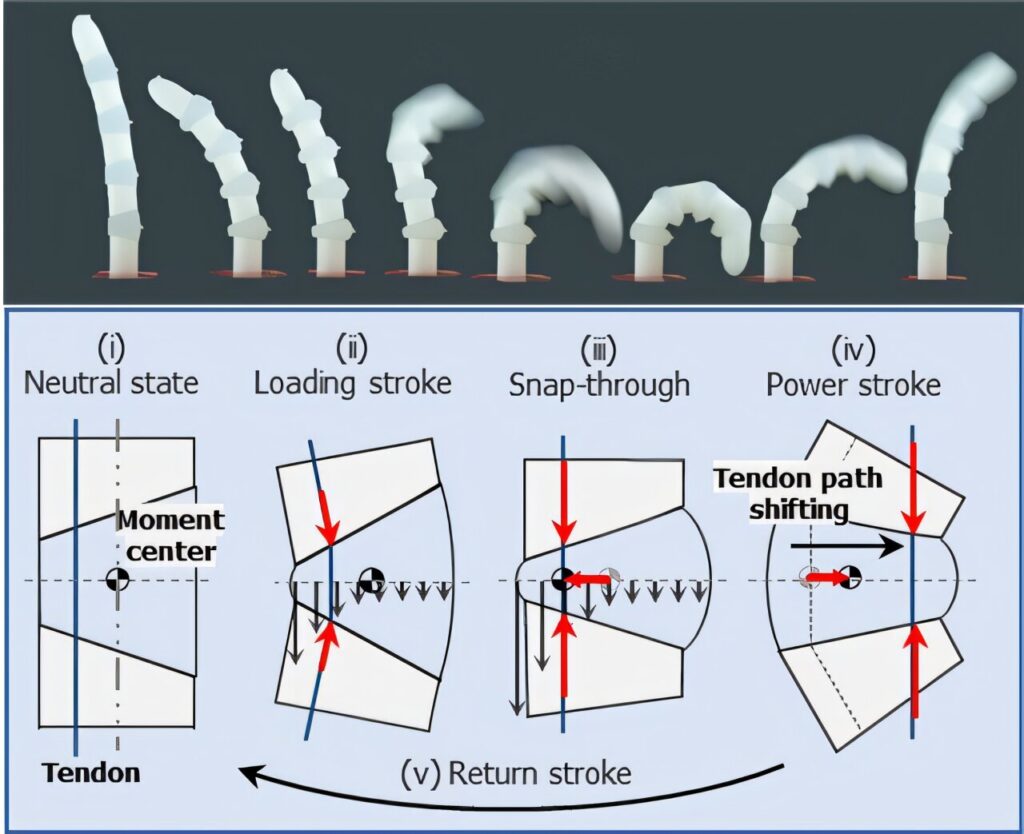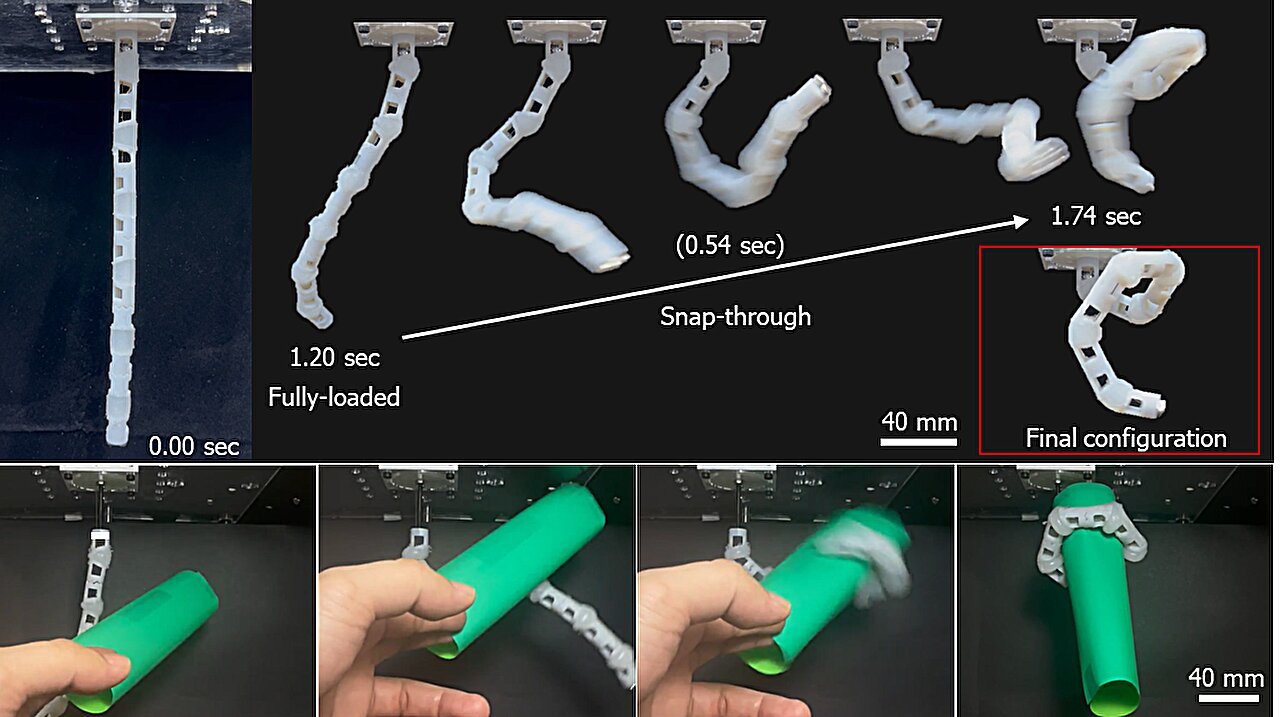In the world of robotics, researchers have often sought to replicate the agility, speed, and power seen in nature’s creatures. A breakthrough in this area has come from a research team led by Professor Kyu-Jin Cho from Seoul National University’s Department of Mechanical Engineering. Their work, published in Science Robotics, introduces the hyperelastic torque reversal mechanism (HeTRM), a novel advancement that allows robots made from soft, rubber-like materials to achieve rapid, powerful movements similar to those of the natural world.
Inspiration from Nature: The Mantis Shrimp and the Flea
Nature is full of fascinating examples of creatures using soft, flexible bodies to generate remarkable power. For instance, the mantis shrimp, a small marine creature, is capable of delivering a punch at speeds of up to 90 km/h, enough to shatter prey with ease. Similarly, the flea can leap distances of over 200 times its body length—an astonishing feat that seems almost impossible given its size.
What makes these organisms so powerful? The secret lies in their torque reversal mechanism, which allows them to quickly change the direction of rotational force applied by their muscles to their limbs. By switching the direction of force instantaneously, these creatures can unleash power far greater than what their soft, flexible bodies would typically suggest.
Professor Cho and his team have taken inspiration from these animals to develop a mechanism that mimics their ability to generate tremendous force through soft materials. This approach could be a game-changer for soft robotics, a field that aims to create machines made of flexible materials that can perform tasks requiring precision and dexterity—often with fewer risks of damage compared to traditional rigid robots.
The Hyperelastic Torque Reversal Mechanism (HeTRM)
The hyperelastic torque reversal mechanism (HeTRM) developed by Cho and his team is based on the principle of hyperelasticity—a property that describes how certain materials, such as rubber, behave when deformed. Unlike traditional materials, which resist deformation, hyperelastic materials can stretch and compress significantly without breaking, making them ideal for soft robots.
HeTRM specifically focuses on how these materials behave under compression. When a hyperelastic material is compressed, it becomes stiffer, and this stiffening can be controlled. The researchers discovered that when compression is concentrated on one side of a flexible joint, the material reaches a critical point where it releases stored energy in a rapid, controlled manner. This rapid release of energy leads to powerful bending motions, which can be used to generate forceful movements.

This mechanism closely resembles the way cilia (tiny hair-like structures found in many organisms) move, bending in a rapid, energy-efficient manner to propel or manipulate objects. With this principle in hand, the team was able to develop robots capable of mimicking these natural motions.
Applications: From Grippers to Crawlers and Wrappers
One of the most exciting aspects of the HeTRM is its versatility. The researchers demonstrated several practical applications that showcase the potential of this technology in the field of soft robotics.
- Soft Gripper: By incorporating the HeTRM into a soft gripper, the team created a robot capable of catching falling ping-pong balls with remarkable speed. This gripper takes advantage of the instantaneous force generated by the torque reversal mechanism, allowing it to capture objects in mid-air before they hit the ground.
- Rough Terrain Crawlers: The team also designed a robot capable of crawling over rough terrain, such as sand. The HeTRM enables the robot to generate strong propulsion, mimicking the movement of creatures that can navigate difficult environments with ease.
- Rapid Wrapping Robot: Perhaps the most impressive application is the robot capable of rapidly wrapping around objects, much like an octopus tentacle. The HeTRM allows the robot to quickly wrap itself around objects, offering unprecedented speed and precision in tasks that require the robot to move and adapt swiftly.
- Mechanical Fuse: In another innovative application, the team developed a mechanical fuse that is triggered when the robot encounters unintended external forces exceeding a certain threshold. This safety feature ensures that the soft robot does not become damaged when exposed to unexpected physical stress, making it even more resilient for real-world use.
These applications show just a glimpse of what HeTRM can achieve. The ability to rapidly produce powerful and controlled movements opens the door to many exciting possibilities in the development of soft robots—from delicate grippers for handling fragile objects to powerful, agile machines capable of navigating challenging environments.
Snap-Through and Material Properties
A unique aspect of this study lies in how the research team has focused not only on structural design but also on material properties. Co-first authors Wooyoung Choi (now at Naver Labs) and Woongbae Kim (currently at the Korea Institute of Science and Technology) explained that the team took inspiration from the behavior known as snap-through. This refers to a rapid transition between two stable states, such as how a slap bracelet changes shape when bent.
Although many previous efforts have attempted to replicate this behavior through structural designs, Cho’s team introduced a novel approach by focusing on the material properties of soft, hyperelastic materials. This new focus allows the researchers to achieve the same effects with greater efficiency and flexibility, opening up new pathways for soft robotics innovation.
A New Era for Soft Robotics
Professor Kyu-Jin Cho expressed his optimism about the future of this technology, stating that HeTRM represents a significant step forward in the field of soft robotics. HeTRM has the potential to expand the horizons of robot design and applications, enabling more flexible, agile, and powerful robots that can perform a wide range of tasks with previously unachievable precision.
As the world increasingly moves toward automation and robotics, the development of soft robots that can interact with humans and the environment in a safe and effective manner will be crucial. The ability to create robots that can move rapidly, handle delicate tasks, and adapt to challenging environments could have wide-ranging impacts in fields like healthcare, logistics, search and rescue, and industrial automation.
Moreover, this research exemplifies the importance of looking to nature for inspiration. By understanding the principles behind the powerful movements of creatures like the mantis shrimp and flea, the research team was able to create a mechanism that brings the best of biology and engineering together.
Conclusion
The hyperelastic torque reversal mechanism (HeTRM) developed by Professor Kyu-Jin Cho and his team represents a breakthrough in soft robotics. By leveraging the unique properties of soft, hyperelastic materials and mimicking natural torque reversal mechanisms found in nature, the researchers have paved the way for robots capable of performing rapid and powerful movements.
From soft grippers to terrain-crawling robots and octopus-like wrappers, the potential applications of this technology are vast. As the field of soft robotics continues to grow, innovations like HeTRM will likely become integral to the development of robots that can safely and efficiently perform tasks in a variety of environments. This research not only advances the field of robotics but also underscores the value of looking to nature for inspiration in the design of cutting-edge technologies.
Professor Cho’s work demonstrates that soft robots are no longer confined to science fiction—they are becoming an increasingly powerful reality. The future of soft robotics, powered by mechanisms like HeTRM, promises to change the way we think about automation, human-robot interaction, and even the very nature of mobility itself.
Reference: A hyperelastic torque-reversal mechanism for soft joints with compression-responsive transient bistability, Science Robotics (2025). DOI: 10.1126/scirobotics.ado7696. www.science.org/doi/10.1126/scirobotics.ado7696
